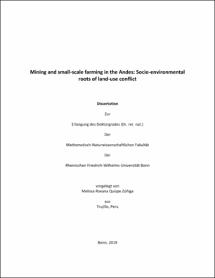Quispe Zúñiga, Melissa Roxana: Mining and small-scale farming in the Andes: Socio-environmental roots of land-use conflict. - Bonn, 2020. - Dissertation, Rheinische Friedrich-Wilhelms-Universität Bonn.
Online-Ausgabe in bonndoc: https://nbn-resolving.org/urn:nbn:de:hbz:5-58301
Online-Ausgabe in bonndoc: https://nbn-resolving.org/urn:nbn:de:hbz:5-58301
@phdthesis{handle:20.500.11811/8307,
urn: https://nbn-resolving.org/urn:nbn:de:hbz:5-58301,
author = {{Melissa Roxana Quispe Zúñiga}},
title = {Mining and small-scale farming in the Andes: Socio-environmental roots of land-use conflict},
school = {Rheinische Friedrich-Wilhelms-Universität Bonn},
year = 2020,
month = apr,
note = {The Peruvian Andes are one of the most important water sources for the country. Therefore, their exploitation might pose critical threats for local farming activities, national economy, and water quantity and quality. At the same time, the Andes have experienced activities of the mining industry over the last decades, which has boosted the national economy. The mining concessions and operations have brought together campesino communities and mining companies. This has led to the escalation of conflicts due to mining impacts on water, the mining-related misinformation, the distribution of mining royalties, and the compensations in return to the rent of campesino community lands to mining companies. Focused on the farming-mining lands, this research adapts mixed-methods to analyze the land-use conflicts and to build a risk index to support decision-making processes. It aims to evaluate the environmental, social and institutional roots of land-use conflicts to model conflicting situations between the small-scale farming communities and mining companies. It follows four key objectives. First, the analysis of heavy metal concentrations in water and soil with land-cover classification and participatory mapping allowed the measurement of key biophysical parameters in farming-mining lands. Second, mixed-methods via semi-structured surveys, in-depth interviews, social and content analyses were used to assess the social and institutional aspects related to the management of water and soil. Third, the results from the multi-criteria analysis were compared with content analysis, surveys and interviews to integrate and consolidate the aforementioned biophysical, social and institutional components in a theoretical framework and land-use conflict risk index. Fourth, three main scenarios were developed to simulate the conflicts between communities and mining companies. The resulting land-use conflict risk index can provide a useful decision-making tool for the governments to tackle conflict management through revealing the conflict-triggering criteria and indicators. Furthermore, this is the first interdisciplinary research that depicts a thorough understanding of the interaction of the fourteen studied campesino communities with state institutions, civil society, and mining companies once the mining concession is given.},
url = {https://hdl.handle.net/20.500.11811/8307}
}
urn: https://nbn-resolving.org/urn:nbn:de:hbz:5-58301,
author = {{Melissa Roxana Quispe Zúñiga}},
title = {Mining and small-scale farming in the Andes: Socio-environmental roots of land-use conflict},
school = {Rheinische Friedrich-Wilhelms-Universität Bonn},
year = 2020,
month = apr,
note = {The Peruvian Andes are one of the most important water sources for the country. Therefore, their exploitation might pose critical threats for local farming activities, national economy, and water quantity and quality. At the same time, the Andes have experienced activities of the mining industry over the last decades, which has boosted the national economy. The mining concessions and operations have brought together campesino communities and mining companies. This has led to the escalation of conflicts due to mining impacts on water, the mining-related misinformation, the distribution of mining royalties, and the compensations in return to the rent of campesino community lands to mining companies. Focused on the farming-mining lands, this research adapts mixed-methods to analyze the land-use conflicts and to build a risk index to support decision-making processes. It aims to evaluate the environmental, social and institutional roots of land-use conflicts to model conflicting situations between the small-scale farming communities and mining companies. It follows four key objectives. First, the analysis of heavy metal concentrations in water and soil with land-cover classification and participatory mapping allowed the measurement of key biophysical parameters in farming-mining lands. Second, mixed-methods via semi-structured surveys, in-depth interviews, social and content analyses were used to assess the social and institutional aspects related to the management of water and soil. Third, the results from the multi-criteria analysis were compared with content analysis, surveys and interviews to integrate and consolidate the aforementioned biophysical, social and institutional components in a theoretical framework and land-use conflict risk index. Fourth, three main scenarios were developed to simulate the conflicts between communities and mining companies. The resulting land-use conflict risk index can provide a useful decision-making tool for the governments to tackle conflict management through revealing the conflict-triggering criteria and indicators. Furthermore, this is the first interdisciplinary research that depicts a thorough understanding of the interaction of the fourteen studied campesino communities with state institutions, civil society, and mining companies once the mining concession is given.},
url = {https://hdl.handle.net/20.500.11811/8307}
}






